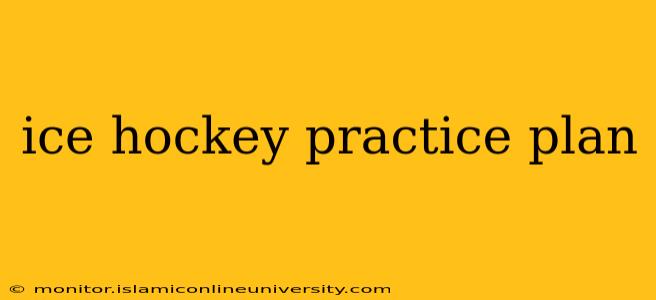Ice hockey is a fast-paced, demanding sport requiring skill, strategy, and relentless practice. This comprehensive guide outlines a sample ice hockey practice plan, adaptable for various skill levels and team needs. We'll cover warm-ups, skill development drills, tactical sessions, and cool-downs, addressing common questions along the way.
Warm-up (15 minutes)
A proper warm-up is crucial to prevent injuries and prepare players both physically and mentally. This should include:
- Light cardio: Jogging around the rink, skating laps at a moderate pace.
- Dynamic stretching: Arm circles, leg swings, torso twists – focusing on movements that mimic skating motions.
- Stickhandling: Simple stickhandling drills while stationary or slowly skating. This gets the hands and eyes coordinated.
Skill Development (30 minutes)
This section focuses on honing individual skills essential for effective hockey play. We'll break it down into key areas:
Shooting Accuracy and Power:
- Wrist shots: Focus on quick releases and accuracy from different positions. Use targets to improve aim.
- Slap shots: Emphasis on proper technique to generate power and control. Drills should include shooting from various distances and angles.
- Snap shots: Practicing a quick, powerful shot ideal for close-range scoring opportunities.
Stickhandling Mastery:
- Cone drills: Navigating cones in various patterns at different speeds to improve puck control and agility.
- D-to-D passing: Partner drills focusing on precise passing and receiving, building quick puck movement skills.
- Around-the-world stickhandling: A classic drill focusing on improving hand-eye coordination and puck control.
Passing Precision and Efficiency:
- Breakaway passes: Practicing accurate and timely passes to a teammate breaking away towards the net.
- Short-range passing: Develop precise passing within close proximity, simulating gameplay scenarios.
- Cross-ice passing: Improving accuracy and speed while executing passes across the ice.
Tactical Sessions (30 minutes)
This segment focuses on implementing strategies and team play, crucial for success in games:
Power Play Strategies:
- Setting up the power play: Practicing different formations and player movements within the offensive zone.
- Shooting lanes and puck movement: Focusing on creating opportunities to shoot, while maintaining puck possession.
- Defensive awareness: Practicing the importance of supporting defensive players during a power play.
Penalty Kill Strategies:
- Defensive positioning: Practicing effective blocking lanes and clearing the puck effectively.
- Breaking up passes: Drills focusing on intercepting passes and disrupting the opposing team's offensive flow.
- Maintaining composure under pressure: Developing mental resilience crucial during stressful game situations.
Neutral Zone Play:
- Puck battles: Drills focusing on winning puck battles and maintaining possession in the neutral zone.
- Forechecking: Practicing aggressive forechecking to put pressure on the opposing team and prevent them from advancing the puck.
- Backchecking: Improving defensive positioning and speed in transitioning back to defend against counter-attacks.
Cool-Down and Review (15 minutes)
The cool-down is as important as the warm-up. This involves:
- Light skating: Slow, easy laps to gradually lower heart rate.
- Static stretching: Holding stretches for 20-30 seconds, focusing on major muscle groups.
- Team review: Discussion of the practice session, focusing on areas of improvement and successful drills.
Frequently Asked Questions (FAQs)
How often should I practice?
The frequency of practice depends on your skill level and team commitments. Generally, 2-3 sessions per week are ideal, allowing for rest and recovery.
What equipment do I need for ice hockey practice?
Essential equipment includes skates, helmet, gloves, stick, shin guards, elbow pads, and shoulder pads. Depending on your role and level, you might also require a jockstrap or protective cup and other protective gear.
How can I improve my skating technique?
Focus on drills that improve your stride, balance, and agility. Consider working with a skating coach for personalized guidance.
What are some good resources for learning more about ice hockey?
Numerous online resources, instructional videos, and books are available to improve your skills and understanding of the game. Look to reputable coaching websites and hockey federations for reliable information.
This practice plan serves as a guideline. Always adjust it based on your team’s needs, skill levels, and available ice time. Remember consistent practice, proper technique, and a focus on both individual skills and team play are crucial for success on the ice.
